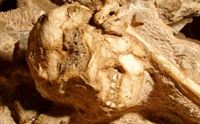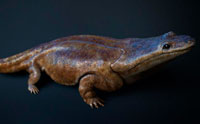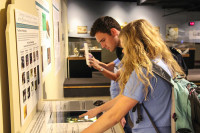By Creation Moments Evolutionists and atheists like to think they’ve got Bible-believing creationists stumped when they ask, “If a worldwide flood really happened, where did all the water go? If Noah’s flood covered the mountaintops, what happened to all that water?” read more …read more Read more here: Creation Moments
By Ken Ham We often receive encouraging testimonies from people who have been strengthened and equipped with AiG resources. I thought I would share with you this testimony from a young lady, now a student at Cedarville University in Ohio, who used our resources as a teenager and found that they helped her navigate through the difficult years of questioning her faith in high school. You can watch Jana’s testimony, filmed and edited by Caleb Caucett: Like Jana said in her video, today’s high school and college students are having their faith assaulted both in and out of the classroom. [More]
By Creation Moments If we can learn anything from science, it’s this – the scientific facts of today won’t necessarily be the facts of tomorrow. The simple truth is that a scientific fact that is no longer a fact was never a fact to begin with! read more …read more Read more here: Creation Moments
By Tom Hennigan Chameleons’ skin color can shift dramatically, and in just a few minutes their colors can revert back to the original. How do they do this? …read more Read more here: AIG Daily
A potential solution to the alarming loss of youth from the churches. …read more Read more here: creation.com
By Ken Ham Earlier this year, BioLogos published the transcript of a conversation that took place between Dr. Hugh Ross, the president of Reasons to Believe, and Dr. Deborah Haarsma, the president of BioLogos, as well as several other theologians and scientists. We’ve written about these compromising organizations before; Reasons to Believe holds to an old-earth, to cosmological and geological evolution, and to progressive creation (which is, in essence, not really much different than theistic evolution), and BioLogos completely accepts secular ideas about the origins of the universe but just says that God used cosmological, geological, and biological …read more [More]
By Ken Ham Every Tuesday and Thursday morning at AiG, we have a special time with the entire staff to start off the work day. We often have a guest pastor or other Christian leader share devotional thoughts with our staff—it’s in an effort to start off the day on an encouraging note. Recently, we were blessed with some special music from AiG friends and volunteers Robb and Kathy Blanchette. They travel around the country in their RV and give several gospel concerts each year, and we have really grown to appreciate their musical talent and their passion for the [More]
By Dr. Danny Faulkner There are at least three problems with Hugh Ross’ local flood model which render it physically impossible. This is in addition to numerous biblical issues. …read more Read more here: AIG Daily
By Creation Moments Humans, birds and seals are all known to navigate by the stars. But now, the lowly dung beetle could be the first example of an insect being a stargazer. These lowly insects appear to use the stars of the Milky Way to know where they are going. Most humans can’t even accomplish that! read more …read more Read more here: Creation Moments
By Steve Ham Many Christians may have missed the mark when it comes to the gospel’s natural outflow—helping people in need. …read more Read more here: AIG Daily
Sea urchin spines are made from a crystal that contains impurities that stop cracks propagating. The fine architecture further strengthens the spine. …read more Read more here: creation.com
A recent MSN article claims a fossilized hominid called “Little Foot” found near Johannesburg, South Africa, is approximately 3.67 million years old, as does a similar report in ScienceNews. Both articles provide insufficient detail to make an intelligent evaluation of the method used to arrive at the stated conclusion, and as such that conclusion must be regarded as suspect. More… …read more Read more here: icr.org
By Creation Moments When most people look at a photo of the Goniurellia tridens fruit fly, they think it must have been created by a talented Photoshop artist. No, this fly with images of ant-like insects on its wings is no accident of nature. The images were put there by a Master Designer. read more …read more Read more here: Creation Moments
By Dr. Danny Faulkner While many Christians support Ross’ broad conclusions, few would agree with the details of Dr. Ross’ argument. …read more Read more here: AIG Daily
Birds are clearly distinct creatures from dinosaurs, with unique lung design, fully-formed feathers, and flying machinery. Even under evolutionary dating, undoubted birds are older than their alleged dinosaur ancestors. …read more Read more here: creation.com
Scientists in Portugal unearthed a “super salamander” which, although “weird compared to anything today,” is still very much a salamander. The fossilized bones of the six-foot animal were discovered on a hillside dig “chock-full” of bones and declared to originate from the “Upper Triassic” period, some 200 million years ago according to evolutionary dating. But creationists see this as yet another discovery of a created animal that grew to large dimensions in the fertile world before the Flood, and was subsequently buried during the Flood itself. More… …read more Read more here: icr.org
By Creation Moments The great scientist James Clerk Maxwell, a contemporary of Charles Darwin, was certainly no friend of Darwin’s theory of evolution. Even so, the staunchest evolutionists today would agree that Maxwell was a scientist of gigantic proportions, ranking right up there with celebrated scientists like Sir Isaac Newton. read more …read more Read more here: Creation Moments
By Ken Ham On Tuesday, I gave an informal update on the Ark project with lots of photos and video clips after having spent a few hours at the site last week. For many people, this is the first time they really started to grasp the enormity of this project. I encourage you to watch this presentation I gave to the staff—it begins with a few short video clips with testimonies I received from the Indiana Home Educators Convention. It will greatly encourage you. Be prepared to have your mind blown as you see the photographs and video clips of [More]
By Multimedia On this episode of ID the Future, host David Boze interviews Dr. Cornelius Hunter about several lines of evidence against Darwinian evolution found in the hammerhead shark. The unique design of the hammerhead’s aerodynamic head, or cephalofoil, includes electromagnetic tracking of prey and binocular vision. Although new research reported in Science Daily gratuitously presents these unique features as a product of unguided evolution, the Darwinian framework fails to offer any insight into how they might have arisen. Dr. Cornelius G. Hunter is Adjunct Professor at Biola University and author of the award-winning Darwin’s God: Evolution and the Problem [More]
Only a biblical view of creation gives us the answer to how God could allow death-and what He is going to do about it. …read more Read more here: creation.com
By Multimedia On this episode of ID the Future, Casey Luskin continues his series discussing the top 10 problems with biological and chemical evolution. This series is based upon Casey Luskin’s chapter in the volume More than Myth, edited by Paul Brown and Robert Stackpole (Chartwell Press, 2014). In this segment, Casey discusses the fifth problem: how abrupt appearance of species in the fossil record does not support Darwinian evolution. Your browser does not support playing Audio, please upgrade your browser or find our podcast on podOmatic Download Episode …read more Read more here: id the future
By Ken Ham Many of our children are fascinated by science and technology. But, sadly, science is the primary method being wrongly used by secularists today to indoctrinate children into evolutionary and atheistic thinking and to get them to doubt God’s Word. But science is a tool that can—and should!—be used to glorify and honor God, not turn students away from God. Well, there is a STEM (science, technology, engineering, and math) camp that teaches students hands-on operational science while also providing them with a strong creation foundation. If this is something your science-loving teen would be interested in, then [More]
By Creation Moments In his book, The Blind Watchmaker, evolutionary evangelist Richard Dawkins famously declared: “Biology is the study of complicated things that give the appearance of having been designed for a purpose.” Yes, seeing design in nature is so natural, so common-sensical that even young children innately know that nature is filled with purposeful design. read more …read more Read more here: Creation Moments
By Multimedia On this episode of ID the Future, Casey Luskin continues his series discussing the top 10 problems with biological and chemical evolution. This series is based upon Casey Luskin’s chapter in the volume More than Myth, edited by Paul Brown and Robert Stackpole (Chartwell Press, 2014). In this segment, Casey discusses the fourth problem: that natural selection struggles to fix advantageous traits in populations. Your browser does not support playing Audio, please upgrade your browser or find our podcast on podOmatic Download Episode …read more Read more here: id the future
A child’s question about the origin of mankind and AIDS reveals the importance of providing biblical answers. …read more Read more here: creation.com
As the genomes of many new creatures rapidly fill the public DNA sequence databases, the problems for the grand evolutionary story are becoming overwhelming. One issue is the fact that different creatures have unique sets of genes specific to their kind with no apparent evolutionary history. To explain this glaring problem, evolutionists have resorted to the myth of pervasive horizontal gene transfer. More… …read more Read more here: icr.org
The more we learn about Enceladus, the younger it looks. Stated another way, the more that our space probes discover about this fascinating little moon that inhabits Saturn’s tenuous E ring, the more challenging it becomes for conventional origins to explain. A new discovery adds to the list of young-looking Enceladus features. More… …read more Read more here: icr.org


















![I Believe He’s Coming Back [Live] I Believe He’s Coming Back [Live]](http://img.youtube.com/vi/6bDjKbMEwoU/0.jpg)



















